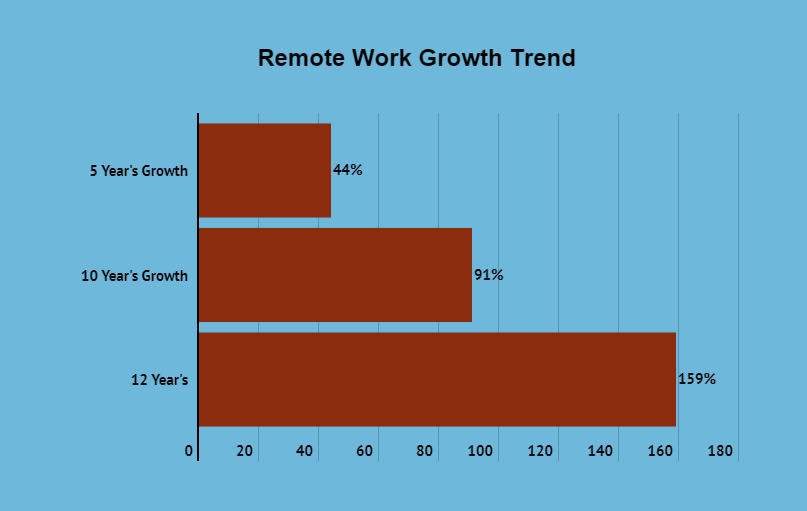Industry report
Remote Workers Statistics And Facts (2020 Report)

Remote working is a new culture, and the shift to the new mode of working offers many advantages to the employees and employers. It is a welcome mode of job, where the physical presence is not essential in the working premise. Many companies happily embrace the new work culture, as it offers reduced operating costs without losing the productivity of the business. Remote work allows more freedom, and employees are happy working from home as they don’t have to commute to the office regularly.
Overview of Remote Workers Statistics And Facts (2020 Report)
- 1 Remote Workers Statistics And Facts (2020 Report)
- 2 Five Key Stats:
- 3 The statistics of remote work:
- 4 New working environment:
- 5 Statistics of remote works at a glance:
- 6 The changing work policy:
- 7 Benefits noticed by companies:
- 8 Benefits for the employees:
- 9 Impact of remote working:
- 10 The number of remote working employees:
- 11 Type of jobs suitable for remote working:
- 12 Work growth:
- 13 Remote work growth trends: (Flexjob)
- 14 HR policy:
- 15 Effect on productivity:
- 16 Earning benefits:
- 17 Most common problems in remote working:
- 18 Conclusion:
Albeit remote working comes with bundles of benefits, like every positive outcome, it also has its own demerits. But the merits can outshine the demerits, especially when the society face pandemic issues and social distancing recommended by the experts. In a given odd situation, allowing employees to work remotely can enhance the morale of the staff and maintain the workflow of the business. When the employees get the care and attention from the employer, the morale rises to the peak, and in return, the employee’s zeal to perform better for the company also increases.
Many times employees take off while facing unexpected eventualities. But when the management listens empathetically to such a call and allows them to work remotely, it instills a sense of security and increases their loyalty towards the company. The following remote work survey reports confirm how it helps to increase productivity and contribute overall growth of the company.
Five Key Stats:
Over 16% of companies worldwide hire only remote teams.
In the last 15 years, the amount of people working from home has increased by 140%
Working from home can help reduce employee turnover by up to 25%.
4.3 million people in the USA already work from home at least half the time
The statistics of remote work:
It is interesting to observe the survey findings of Buffer.com conducted in 2019 on 2500 individuals. The survey deals with the struggles, benefits, and various aspects of remote working and how a remote worker evaluates the remote job. (Buffer)

- 99% love to work remotely, and only 1% cast NO to the concept. (Buffer)
- 95% like to encourage others to work remotely. (Buffer)
- 40% agree with its flexibility as a benefit. (Buffer)
- 30% are happy with the arrangements, as it allows them to work from any location. (Buffer)
- 14% find it is beneficial as it offers more time to spend with family. (Buffer)
- 13% love working from home. (Buffer)
- 3% happy to work home, siting another reason. (Buffer)
New working environment:
Remote working has become an acceptable practice in many companies, and government and companies are promoting the concept, as many jobs can do virtually by not having a physical presence in the office. It is popular among the freshers,’ but the seniors in all industries also prefer it. It is the most accepted and appreciated trend in the professional world. Working from a remote location is the more widely accepted option than sitting in an office set up.

- 74% of people believe that working from any remote location is the ‘new normal’ for almost all industries. (Flexjobs)
- The growth of remote working in a period of one year from 2016 to 2017 has been 7.9% in the US alone. (Flexjobs)
- In 2019, the remote work in the US was 66% more than the global average (Owllabs)
- When making a comparison for a period of 5 years from 2012 to 2017, the growth percentage is 44%. (Flexjobs)
- And over the last ten years 2007 to 2017, there has been a growth of 91%. (Flexjobs)
- If we compare the remote working growth from the year 2005 to 2017, an increase of 159% has noticed. (Flexjobs)
- In terms of number, in the year 2015, 3.9 million people were working from a remote location, which has risen to 4.7 million in 2017, amounting to 3.4% of the total population. (Flexjobs)
Statistics of remote works at a glance:

- 3 million people in the US work remotely at least half the time. (smallbizgenius)
- 140% growth has registered in the number of remote workers since 2005. (smallbizgenius)
- 115% increase has found in telecommuting within the last 10 years. (smallbizgenius)
- About 16% of companies hire remote workers. (smallbizgenius)
- On a global scale, about 52% of employees work from home at least once a week. (smallbizgenius)
- On a global scale, 18% of employees work remotely full-time. (smallbizgenius)
- 40% of people like remotely working due to flexibility. (smallbizgenius)
- 44% of companies won’t allow remote working. (smallbizgenius)
- 73% of departments will have remote workers by 2028. (smallbizgenius)
The changing work policy:
The work from a remote location has been in use as part of the retention policy by many firms. Since the new norm is not an unusual thing to society, people get easily adjusted to social pressure, something like we faced in the present COVID-19 pandemic situation. The idea behind the retention policy was to hold good employees with the company who cannot come to the office due to one reason or another and allow them to work from home. The following statistics will reveal the aspects behind the concept.
- As many as 80% of people related to the non-labor-intensive sector refuse to take up a job that does not allow flexible working options. (Flexjobs)
- ⅓ of the professionals believe that being allowed to work from a remote location represents having a prestigious role in the company. (Flexjobs)
- ¾ of the people also believe that remote working is one of the ways to retain a good employee, which does not involve any increase in the cost to the company. (Flexjobs)
Benefits noticed by companies:
Companies that allowed employees to work from remote locations have seen a few advantages in their turnover and efficiency of workers. The following data will explain to us to understand it clearly.

- 85% of businesses that use flexible working have registered increased productivity. (Flexjobs)
- 90% of employers believe that a flexible working environment is a reason to boost the morale of the employee. (Flexjobs)
- While 77% of businesses using remote working have noticed a decrease in the operating cost. (Flexjobs)
- An employee with remote working is 57% more satisfied with their current job in the US. (Flexjobs)
- 80% of remote workers admit that they feel less stressed or just moderately stressed at times only. (Flexjobs)
- 65% of remote workers are more productive as compared to those in the office. (Flexjobs)
- 50% of the remote workers take lesser sick leaves. (Flexjobs)
- 56% of remote workers have reduced average leave options. (Flexjobs)
Benefits for the employees:
While working remotely, employees get multiple benefits. Let us check those benefits and how it relates to the remote working.
- 86% of remote workers feel that it helps to balance work and personal life in a better way. (Flexjobs)
- 86% also think that this practice helps them reduce work stress. (Flexjobs)
- 89% of employees feel they get a better chance to take care of themselves as they are saving time for commutation. (Flexjobs)
- A remote worker can averagely earn $4,000 more per year; in terms of saving as he/she does not have to spend on commuting. (Flexjobs)
- 42% of the people who solely work from a remote location have been doing so for more than five years. (Flexjobs)
- 28% have been working from 3 to 4 years, and 19% have continued from 1 to 2 years. (Flexjobs)
- The trend is here to stay. (Flexjobs)
Impact of remote working:
Remote works develop healthy inter-related effects on the environment as well as the society and other industry sectors. There have been positive outcomes of this flexible work culture on different people.
- In 2017 the number of people working from home helped get 600,000 cars off the road, as a result of reducing pollution and traffic. (Flexjobs)
- If this service could extend to all those possible, there could be 10million lesser cars on the road. (Flexjobs)
- Remote workers prefer to change their homes to move to a better place. 28% prefer a change in the house, and 24% even look for a change in location, as they no longer need to go to the office and need a dedicated place to work from home. (Flexjobs)
- 41% of companies offered work from home in 2017. (Flexjobs)
- As per a projection, about 73% of companies may offer remote working by 2028. (Flexjobs)
- As many as 75% of current working populations would prefer remote working for the rest of their career tenure. (Flexjobs)
The number of remote working employees:
Not all can work from a remote location, but most of us certainly can. The non-labor-intensive industry can offer remote work options to a great extent to its employees. So here is the data to understand the share.
- 7 million employees in the US, making up 3.4 % of the whole workforce work from home a minimum of half of the week. (blog. HubSpot)
- 62% of the employees in the age group of 22 to 65 occasionally work from home. (hubspot)
- 44% of employees have full-time remote working members on their team. (hubspot)
- 30% of the workforce is fully working from a remote location, whereas 18% work from home one to three times per week. (hubspot)
Type of jobs suitable for remote working:
All sorts of jobs cannot do from a remote location. Agriculture or manufacturing is such a work which need the worker in the workplace; they are mostly called blue-collar jobs. But many jobs can do remotely, such as most of the white-collar jobs.
- 185 of the total executives can work from a remote location rather than in the office. (hubspot)
- 35% of the individual contributors to a business. (hubspot)
- 30% of the people that report to a company can work fully from a remote location. (hubspot)
- 46% of the C-suite members of a company. (hubspot)
- 55% of the VPs can work remotely at a given time. ( hubspot)
Work growth:
The professional growth does take place even when an employee is working from a remote location. It has positive effects on the growth of the person. When a person feels less stressed, the bliss of peace and tranquility empowers them to perform better.
- In the last seven years, those who have been working remotely at least once per week had 400% growth since 2010. (hubspot)
- 42% of remote workers want to increase the time they work remotely. (hubspot)
- In the years 2017 to 2018, there has been an increase of 22% in the telecommuting. (hubspot)
- As many as 99% of the working people would like to work from a remote location at least for some time if not possible full time. (hubspot)
- All those who are in a full-time office job; at least half prefer to work remotely. (hubspot)
- 95% of the people support their family and friends to work from a remote location. (hubspot)
Remote work growth trends: (Flexjob)

HR policy:
Selecting candidates who are ready to work remotely is a good recruitment policy and also an excellent retention policy which does not cost extra to the company. It indirectly contributes in the form of perks like time for family, saving from commuting expenses, and besides, the remote worker can enjoy working from the comfort of their home.
- 72% of the professionals believe that shortly remote working will play a major role in HR policies. (hubspot)
- 83% of all workers feel that remote working gives them a happy feeling. (hubspot)
- 40% of the workers feel that flexible timing is the best part of remote working for an employee. (hubspot)
- 30% believe that the freedom to work from anywhere is a bonus perk. (hubspot)
- While 14% like the extra time they can spend with family. (hubspot)
- 81% of employees prefer referring to a job that allows remote working to other people too. (hubspot)
- 74% of employees like to stick to a job that allows remote working. (hubspot)
Effect on productivity:
Working from a remote location makes the employee more productive, or they never tend to dodge work. Mostly, people work seriously and more efficiently while working remotely. It can understand from the following data.
- 77% of employees feel an increase in productivity while working from home. (hubspot)
- 76% of people prefer to avoid going to the office and work only from home when they really need to concentrate on a certain project. (hubspot)
- 23% of the workers feel that they work longer when they work from their homes. (hubspot)
- 53% of the employees take lesser time off than they would have taken if they were working in an office set up. (hubspot)
- 43% of the remote location workers avail less than three weeks of paid leave in a year. (hubspot)
- 84% of the remote working employees prefer to work from their own homes. ( hubspot)
Earning benefits:
Remote work showers with lots of monetary benefits for employees as well as employers. However, on many occasions, the employees may have to pay the price for the convenient option. Sometimes, they face the brunt of salary cuts in return for the option to work from home. The companies generally cut the salary in return for saving travel time, and the time saved can spend with their family and work from your own sweet house.
- The income of 74% of remote workers is less than $100,000 annually. (hubspot)
- Less than 34% of the employees agree to accept a cut of 5% in return for getting to work from a remote location daily. (hubspot)
- 24% of the employees are okay with even a 10% cut to get a remote working option regularly. (hubspot)
- 69% of the millennials are willing to abandon all the other benefits of receiving flexible timings. (hubspot)
- 75% of the remote workers state that their companies do not compensate for internet usage to work from home. (hubspot)
- 30% of the people working remotely can save up to $5,000 due to non-traveling. ( hubspot)
- In the case of co-working space requirements, 71% of the companies are not willing to pay for the employee, as it is not their own premises. (hubspot)
- Businesses, on average, can save up to $11,000 per year if even employees become half time remote workers. (hubspot)
Most common problems in remote working:
Working from a remote location is not always a bed of roses. It has its own problems and technical issues too. Companies, as well as the employees, also face issues, and it varies according to the situations.
- More than 50% of the remote working employees feel that they are unable to maintain the inter-colleague relationship. (hubspot)
- 22% of the remote workers feel that getting unplugged from work is their biggest challenge. (hubspot)
- 19% of the remote workers feel the problem of feeling lonely is their major challenge. (hubspot)
- Around 50% of the employees feel that there is a lack of internet security training and safety in remote working, which can put their data at risk. (hubspot)
Conclusion:
As per the above data, we can see that remote work offers many benefits for the employees and employers. Remote work helps to reduce the impact on the environment and to give it a chance to rejuvenate itself. Also, companies can reduce the operation cost, and the employee gets the best perk in terms of human hours saved, which they can spend with family.
But remote work also has some negative points, and one of the significant problems is maintaining the security of data. Another tricky issue is the salary reduction policy of companies in return for giving then remote working options. But after careful analysis, it looks like the remote work option is to stay here, and many companies embrace the system as part of their HR policy. It can effectively use to check the global pandemic where social distancing becomes a necessary tool and useful during natural calamities.
Source links:
https://buffer.com/state-of-remote-work-2019
https://www.flexjobs.com/blog/post/remote-work-statistics/
https://www.owllabs.com/blog/remote-work-statistics
https://blog.hubspot.com/marketing/remote-work-stats
https://www.smallbizgenius.net/by-the-numbers/remote-work-statistics/#gref
Explore Related reccomendations
Dropbox Statistics, Users, Growth And Facts For 2021
- According to 0 users
Etsy Statistics, Users, Usage, Demographics (2021 Report)
- According to 0 users
TikTok Statistics, Usage And Facts (2020 Report)
- According to 0 users
Facebook live Statistics, Usage And Facts (2020 Report)
- According to 0 users


